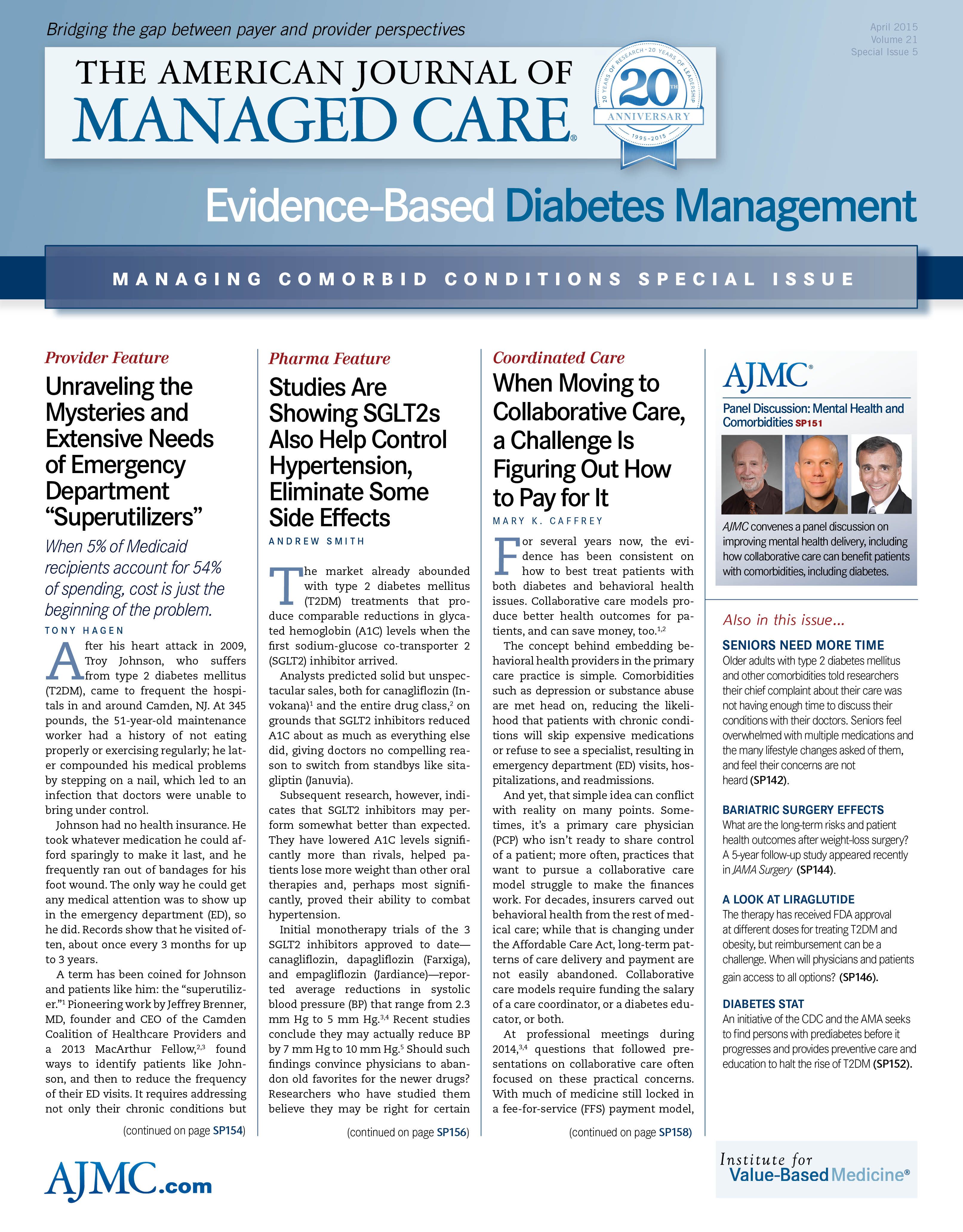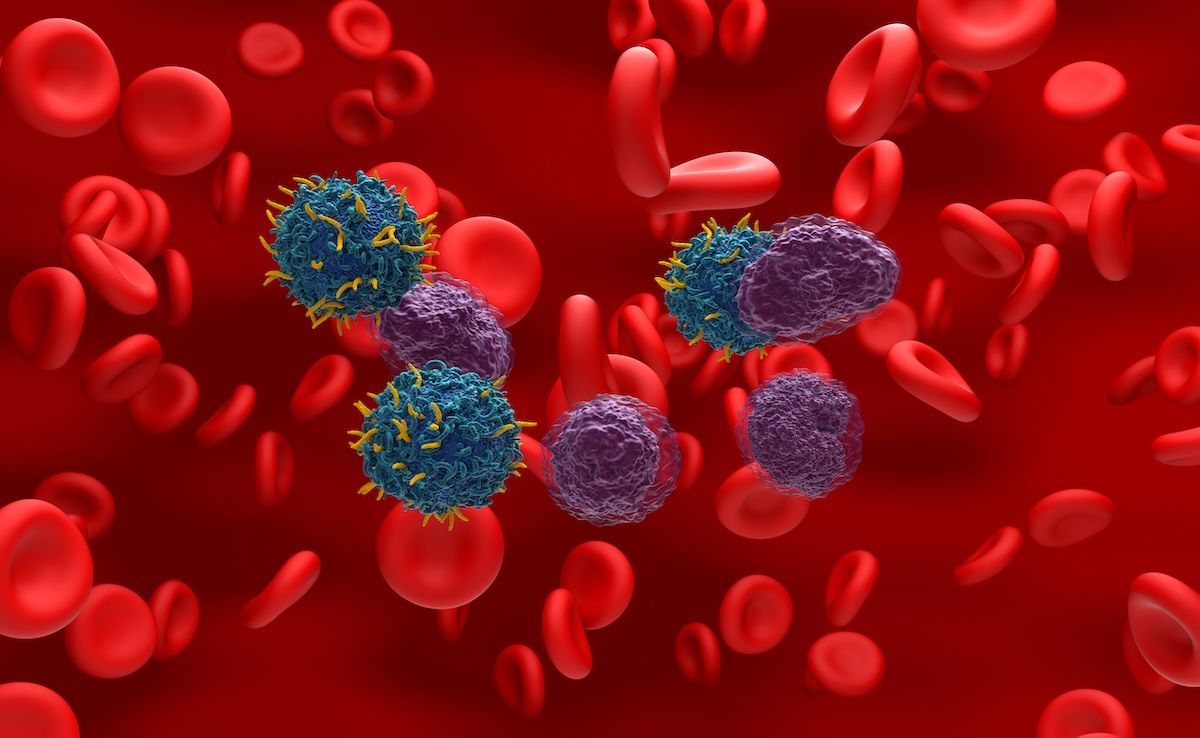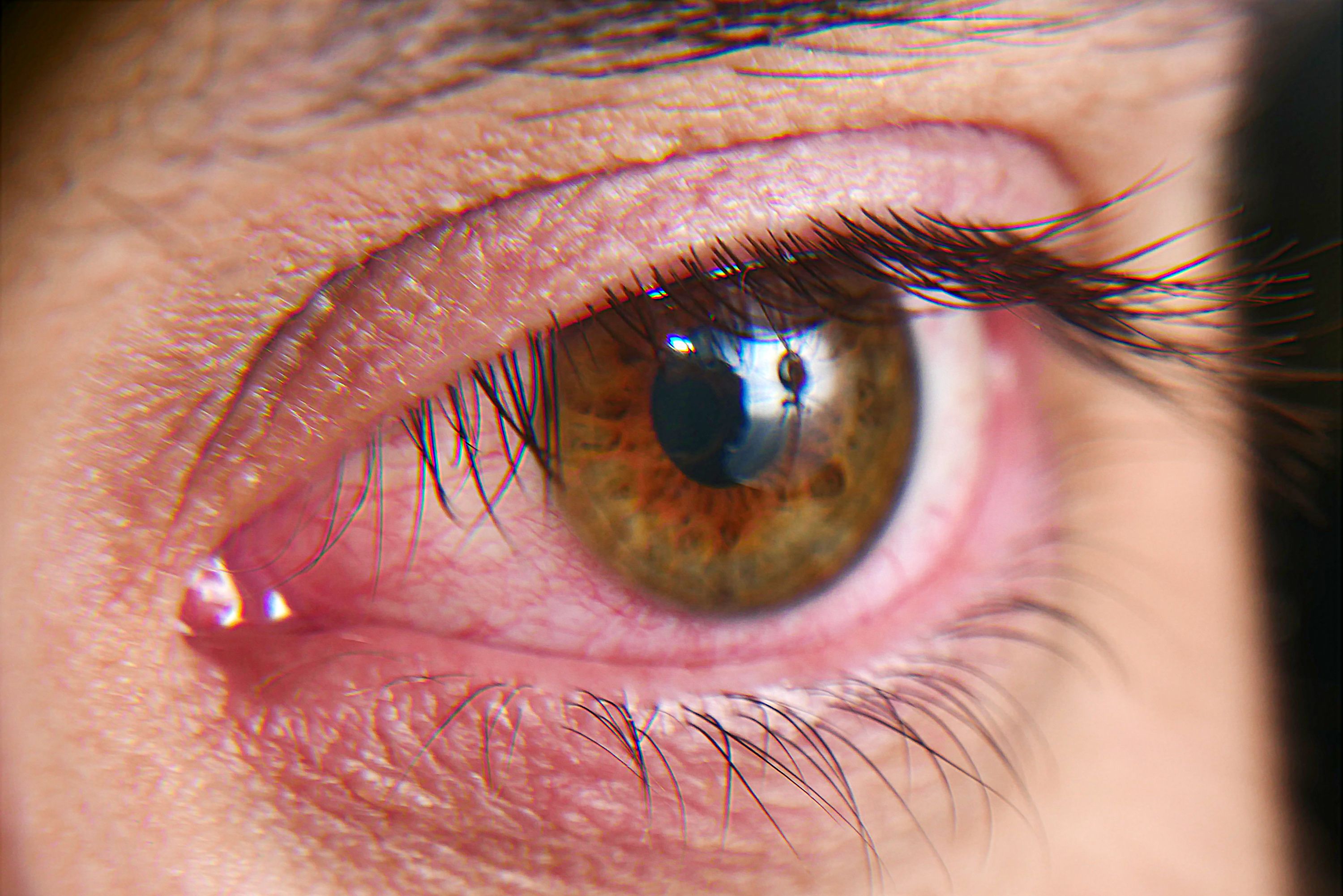Publication
Article
Evidence-Based Diabetes Management
Studies Are Showing SGLT2s Also Help Control Hypertension, Eliminate Some Side Effects
Author(s):
Real-world studies of SGLT2 inhibitors show that this new class of drugs for type 2 diabetes has lowered A1C more than rivals. Patients lose more weight than with other oral therapies, and the benefit of controlling hypertension may make it possible for some patients to stop taking other drugs.
The market already abounded with type 2 diabetes mellitus (T2DM) treatments that produce comparable reductions in glycated hemoglobin (A1C) levels when the fi rst sodium-glucose co-transporter 2 (SGLT2) inhibitor arrived.
Analysts predicted solid but unspectacular sales, both for canagli ozin (Invokana)1 and the entire drug class,2 on grounds that SGLT2 inhibitors reduced A1C about as much as everything else did, giving doctors no compelling reason to switch from standbys like sitagliptin (Januvia).
Subsequent research, however, indicates that SGLT2 inhibitors may perform somewhat better than expected. They have lowered A1C levels significantly more than rivals, helped patients lose more weight than other oral therapies and, perhaps most significantly, proved their ability to combat hypertension. Initial monotherapy trials of the 3 SGLT2 inhibitors approved to date—canagli ozin, dapagli ozin (Farxiga), and empagli ozin (Jardiance)—reported average reductions in systolic blood pressure (BP) that range from2.3 mm Hg to 5 mm Hg.3,4 Recent studies conclude they may actually reduce BP by 7 mm Hg to 10 mm Hg.5 Should such ndings convince physicians to abandon old favorites for the newer drugs? Researchers who have studied them believe they may be right for certain patient groups. “The trial results suggest that SGLT2 inhibitors could be slightly better than other options for most patients with type 2 diabetes and quite a bit better for some patients who receive multiple medications for each condition,” said Michael A. Weber, MD, a professor of medicine at the SUNY Downstate College of Medicine, in an interview with Evidence-Based Diabetes Management.
“When you start using an SGLT2 inhibitor to control diabetes in such patients, you can often eliminate the diuretic component of their blood pressure regimen,” said Weber, who is also his school’s assistant dean for research. “SGLT2 inhibitors produce similar diuretic effects—and work as well in combination with calcium channel blockers, ACE inhibitors, and others—but they seem to spare patients the risk of hypokalemia and uric acid buildup associated with traditional diuretics.”
The substitution of an SGLT2 inhibitor for a diuretic eliminates a major safety risk for gout-prone patients, but Weber believes that physicians should at least consider the swap in all patients who receive a diuretic as part of combination therapy for hypertension. Such a recommendation has broad implications for SGLT2 inhibitor usage. More than 70% of all diabetics also suffer from high BP,6 and many of them take the diuretics that the American Heart Association and American College of Cardiology recommend as the cornerstone of blood pressure treatment.7
The obvious link between T2DM and hypertension is obesity. A body mass index above 30 greatly increases the risk of developing either condition, or both. There are additional shared risk factors, including poor diet, insuf cient exercise and others, but all of them combined are insuf cient to explain why so many people have both conditions.
If they were fundamentally independent ailments that happened to share a number of risk factors, a person with a 60% risk of developing hypertension and a 60% risk of T2DM would have a 36% of developing both. In reality, the odds would be signi cantly higher, which suggests a deeper tie that has yet to be discovered. Genetic predisposition provides the obvious explanation—and may ultimately prove to be the correct explanation—but research to date argues otherwise. There’s relatively little overlap between the genes that are currently known to increase the risk of T2DM and those that are known to increase the risk of hypertension, according to George L. Bakris, MD, professor of medicine at the University of Chicago and the director of the ASH Comprehensive Hypertension Center.
Ongoing investigation of SGLT2 inhibitors, if it can fully explain the effect such medications have on BP, may help to explain the mystery. Researchers initially believed the diuretic effect of the drugs, combined with their tendency to promote weight loss, deserved the credit, but trial results eventually contradicted this hypothesis.
All medications in the class reduce A1C levels by reducing the amount of glucose that enters the blood via SGLT2 in the proximal renal tubules. This, in turn, increases the amount of glucose excreted via urine, increases the total amount of urine that users excrete and creates the diuretic effect.8
Trials revealed, however, that certain kinds of renal impairment can prevent this entire chain of events, including the increase in urine volume and the diuresis. If diuresis produced the blood pressure reductions (even in part) then people with such kidney problems would miss out on some or all of the BP benefit. In reality, such people see their BP decline about as much as other patients who take SGLT2 inhibitors.9
Researchers still believe diuresis produces some of the effect in many patients. They acknowledge, however, that many questions remain unanswered. “The precise mechanism of the blood pressure drop remains incompletely elucidated,” wrote the authors of a recent paper on SGLT2 inhibitors and BP in the Journal of the American Society on Hypertension. “Based on current data, the blood pressure reduction is partially due to a combination of diuresis, nephron remodeling, reduction in arterial stiffness, and weight loss.”10
History suggests that the mystery may endure. Thiazides have been around since the 1950s and studies have yet to explain exactly why they lower blood pressure as much as they do.11 History also suggests that mysterious mechanisms are no barrier to usage. Thiazides have ranked among the world’s most common and most useful medications for decades.
SGLT2 inhibitor sales have already topped some initial projections. Canaglifl ozin alone generated about $200 million in fourth quarter revenue of 2014, and many now expect usage to keep growing.12
A signi cant majority of hypertensive diabetics consistently fails to keep BP below target levels,13 and a signi cant minority of all people with T2DM fails to keep A1C levels within target levels.14 In
cases where the problem re ects the inadequacy of treatment regimens (rather than poor patient compliance), guidelines advise physicians to change those regimens or expand them by adding a new class of drug. There are, of course, many drug classes to choose from, but SGLT2 inhibitors have a number of unique strengths beyond BP regulation.
“They have a truly novel mechanism of action, so when you add them to a regimen, you really get added bene t rather than partial duplication. They also tend to be very well tolerated on their own and in combination with other medications,” Bakris said in an interview.
Bakris noted that SGLT2 inhibitors can produce urinary tract infections in some patients, especially uncircumcised men and women with a history of the problem, but argued that reports have exaggerated this side effect; he said this has distracted attention from more important therapeutic issues and should not stop patients from trying the class. “SGLT2 inhibitors, as a class, tend to push everything in the right direction, not just A1C and blood pressure, but also diet and weight,” Bakris said. “People who use these drugs tend to start eating better because they quickly realize that high-carb foods make them pee far, far more frequently than low-carb foods. People who use these drugs also tend to lose more weight than people who use other oral medications. That extra weight loss probably comes from the improved diet, but whatever the explanation, it’s something that many physicians should pay more attention to. Patients who switch from treatments that promote weight gain, which are still common, to those that promote weight loss can drop 10 pounds of fat. Even if nothing else changes, that’s a big improvement.”
Of course, such a substitution in a patient’s diabetes regimen would probably produce other changes. The patient’s BP would be likely to fall, and, according to at least 1 large study, A1C levels might also drop. The trial compared canagli ozin to sitagliptin for A1C control and found that the addition of the former drug to a regimen of metformin and sulfonylurea produced an average reduction of 1.03 percentage points after 52 weeks while the addition of the latter produced an average reduction of 0.66 percentage points. Patients who took canagli ozin, moreover, lost an average of 2.5 kg (5.5 lb) and saw their systolic blood pressure fell by 5 mm Hg. Patients who took sitagliptin generally gained a small amount of weight and saw no change in BP.15
If such results inspire physicians to substitute an SGLT2 inhibitor for sitagliptin, it will be good news for companies that make the latter class of drug. Sitagliptin sales (alone and in a formulation that combines it with metformin) approached $6 billion in 2013.16 If physicians prefer to add an SGLT2 inhibitor to sitagliptin, trials support that idea. The addition of dapagli ozin to sitagliptin, with or without metformin as a third treatment, reduced A1C levels by an average of 0.5 percentage points, based on a 24-week multicenter phase 3 study involving 432 patients who were randomized to receive dapaglifl ozin 10 mg/day or placebo added to sitagliptin (100 mg/day), with or without metformin. The results were published in March 2014 in Diabetes Care.17
Trials have yet to compare any SGLT2 inhibitor against metformin, used with or without a separate drug for hypertension, as an initial treatment for patients with mild elevations in both A1C and BP. There is, however, a theoretical case to be made for the idea.
Monotherapy trials of the 3 SGLT2 inhibitors report average reductions in A1C levels that range from 0.74 percentage points to 1.03 percentage points,18-20 along with the average reductions in systolic blood pressure that range from 2.3 mm Hg to 5 mm Hg. While metformin and stand-alone BP medications can produce signi cantly greater effects, their relative strength may not help those who don’t need it to reach targets.
SGLT2 inhibitors, moreover, are often (but not always) better tolerated than metformin, let alone a combination of metformin and a second medication. Their most common side effect is the weight loss, typically in the range of 2 kg to 3 kg,21 which is rare for metformin users. The best reasons for sticking with metformin, beyond the possible benefi ts of pushing A1C levels further below the 7% threshold, stem from its age. Metformin (like many blood pressure medications) sells in generic form for less than one-tenth the $350 monthly price of branded SGLT2 inhibitors that still enjoy years of patent protection. The older drug also has enough of a track record to assure physicians and patients about its long-term safety. For SGLT2 inhibitors, however, there are some unanswered questions.
Concerns that dapagli ozin might trigger breast and bladder cancer led the FDA to delay that drug’s approval until follow-up data arrived.22 Concerns that canagli ozin might trigger cardiovascular events and other health problems led 5 of the 15 members on an FDA review panel to recommend against its approval.23 The agency has ordered drug makers to conduct multiple postmarketing studies for all 3 SGLT2 inhibitors. Johnson & Johnson, for example, must complete 5 separate studies of canaglifl ozin24:
• a cardiovascular outcomes trial
• an enhanced pharmacovigilance program that monitors malignancies, serious cases of pancreatitis, severe hypersensitivity reactions, photosensitivity reactions, liver abnormalities, and adverse pregnancy outcomes
• a bone safety study
• a pediatric pharmacokinetic and pharmacodynamic study
• a pediatric safety and ef cacy study Weber and Bakris both believe that lingering concerns about safety have slowed the adoption of SGLT2 inhibitors, and they both believe those concerns are probably misplaced.
Follow-up research has addressed the questions raised by some earlier trials, they say, leaving no more reason to worry about the long-term safety of SGLT2 inhibitors than that of any other new drugs that doctors eagerly embrace.
Those same trials, meanwhile, have clearly demonstrated that SGLT2 inhibitors produce unique benefi ts and may thus prove to be considerably more useful than many originally expected.
REFERENCES
1. Clarke T. US FDA approves Johnson & Johnson diabetes drug, canagliflozin. Reuters website. http://www.reuters.com/article/2013/03/29/johnsonjohnson-diabetes-idUSL3N-0CL1FV20130329. Published March 29, 2013. Accessed February 17, 2015.
2. Market brief: The market for type 2 diabetes therapeutics; key findings from a recent analysis of global drug development efforts. Drug Development and Delivery website. http://drug-dev.com/Main/Back-Issues/MARKET-BRIEF-The-Market-for-Type-2-Diabetes-Therap-641.aspx. Published November 19, 2013. Accessed February 17, 2015.
3. Simon JL, Timaeus S, Misita C. SGLT2 inhibitors: a new treatment option for type 2 diabetes. Pharmacy Times. http://www.pharmacytimes.com/publications/health-system-edition/2014/September2014/SGLT2-Inhibitors-A-New-Treatment-Option-for-Type-2-Diabetes. Published September 17, 2014. Accessed February 17, 2015.
4. Tikkanen I, Narko K, Zeller C, et al. Empagliflozin reduces blood pressure in patients with type 2 diabetes and hypertension [published online September 30, 2014]. Diabetes Care. doi:10.2337/dc14-1096.
5. Oliva RV, Bakris GL. Blood pressure effects of sodium-glucose co-transport 2 (SGLT2) inhibitors. J Am Soc Hypertens. 2014;8(5):330-339.
6. Klein R, Klein BEK, Lee KE, Cruickshanks KJ, Moss SE. The incidence of hypertension in insulin-dependent diabetes. Arch Intern Med. 1996;156(6):622-627.
7. Go AS, Bauman MA, Coleman King SM, et al. An effective approach to high blood pressure control: a science advisory from the American Heart Association, the American College of Cardiology and the Centers for Disease Control and Prevention. Hypertension. 2014; 63:878-885.
8. Jabbour SA. SGLT2 inhibitors to control glycemia in type 2 diabetes mellitus: a new approach to an old problem. Postgrad Med. 2014; 126(1):111-117.
9. Kohan DE, Fiorett P, Tang W, List JF. Long-term study of patients with type 2 diabetes and moderate renal impairment shows that dapagliflozin reduces weight and blood pressure but does not improve glycemic control. Kidney International 2014; 85:962-971.
10. Maliha G, Townsend RR. SLGT2 inhibitors: their potential reduction in blood pressure. J Am Soc Hypertens. 2015; 9(1):48-53.
11. Hughes AD. How do thiazide and thiazide-like diuretics lower blood pressure? J Renin Angiotensin Aldosterone Syst. 2004;5(4):155-160. 12. Williams S. 5 things Johnson & Johnson’s management wants you to know. Motley Fool website. http://www.fool.com/investing/general/2015/01/26/5-things-johnson-johnsons-management-wants-you-to.aspx. Published January 26, 2015. Accessed February 17, 2015.
13. El-Shafie K, Rizvi S. Control of hypertension among type 2 diabetes. Oman Med J. 2010; 25(1):32-36.
14. Harris MI, Eastman RC, Cowie CC, et al. Racial and ethnic differences in glycemic control of adults with type 2 diabetes. Diabetes Care. 1999;22(3):403-408.
15. Schernthaner G, Gross JL, Rosenstock J, et al. Canagliflozin compared with sitagliptin for patients with type 2 diabetes who do not have adequate glycemic control with metformin plus sulfonylurea. Diabetes Care. 2013;36(9):2508-2515.
16. Merck announces 4th quarter and full year 2013 results [press release]. Whitehouse Station, NJ: Business Wire; February 5, 2014. http://www.businesswire.com/news/home/20140205005626/en/Merck-Announces-Fourth-Quarter-Full-Year-2013-Financial-Results#.VOO5J_nF-Sp.
17. Jabbour SA, Hardy E, Sugg J, Parikh S. Dapagliflozin is effective as add-on therapy to sitagliptin with or without metformin: a 24-week multicenter, randomized, double-blind, placebo-controlled study. Diabetes Care. 2014;37(3):740-750.
18. Invokana website. Invokana monotherapy provided statistically significant reductions in A1C vs placebo at 26 weeks. http://www.invokanahcp.com/clinical-research-results/monotherapy-vs-placebo/A1C-reductions. Accessed February 17, 2015.
p 19. Roden M, Weng J, Eilbracht J, et al. Empagliflozin monotherapy with sitagliptin as an active comparator in patients with type 2 diabetes: a randomized, double-blind, placebo-controlled, phase 3 trial. Lancet Diabetes Endocrinol. 2013;1(3):208-219.
20. Ferrannini E, Ramos SJ, Salsali A, Tang W, List JF. Dapagliflozin monotherapy in type 2 diabetic patients with inadequate glycemic control by diet and exercise: a randomized, double-blind, placebo-controlled, phase 3 trial. Diabetes Care. 2010;33(10):2217-2224.
21. Bailey CJ, Day C. SGLT2 inhibitors: glucuretic treatment for type 2 diabetes. Medscape website. http://www.medscape.com/viewarticle/726748_1. Accessed February 18, 2015.
22. Edney A. Bristol-AstraZeneca drug wins US FDA approval. Bloomberg News website. http://www.bloomberg.com/news/articles/2014-01-08/bristol-astrazeneca-diabetes-drug-wins-u-s-fda-approval. Published January 8, 2014. Accessed February 17, 2015.
23. Tucker ME. Most FDA advisers support diabetes drug canagliflozin, despite CV concerns. Medscape website. http://www.medscape.com/viewarticle/791413. Published January 11, 2013. Accessed February 17, 2015.
24. FDA approves Invokana to treat type 2 diabetes [press release]. Silver Spring, MD: FDA Newsroom; March 23, 2013. http://www.fda.gov/NewsEvents/Newsroom/PressAnnouncements/ucm345848.htm.






